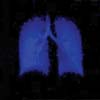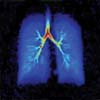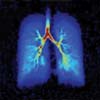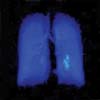 |
 |
| current issue |  |
past issues |  |
send a letter/news |  |
address update |  |
advertise |  |
about us |  |
alumni home |
Features
View FinderPage 2 of 2
When his grant ran out, it looked as if the project might die. Hersman persevered, however, and in 2003, the National Institutes of Health awarded Hersman two grants totaling $3.7 million to continue the work. More recently, NIH awarded Xemed $300,000 in Small Business Technology transfer grants to commercialize the technology, and Hersman anticipates another $2 million over the next few years. The grants will allow Xemed to further refine the technology and shrink the size of the polarizer.
"As a diagnostic tool, lung MRIs could benefit millions with chronic obstructive pulmonary disease, the fourth leading cause of death in the United States. There's also "a significant potential for medical cost savings by extending the frontiers of noninvasive diagnostics," he notes.
But to make the device practical, Herman's team had to fit it into a cabinet small enough so that every hospital with an MRI unit could have one. "The challenge is to bring everything together into a small space without the magnetic fields involved interfering with one another," he says.

|

|

|

|

|
NOW WE'RE COOKING WITH GAS: Polarized xenon would allow doctors to see inside the lungs much the way polarized helium reveals a human lung inhaling and exhaling, above.
UNH has already filed for three patents based on Hersman's innovations and is in the process of filing for two more. "This is great for UNH and New Hampshire because students can continue to be involved in the development of the technology," says Robert Dalton, director of UNH's Office of Intellectual Property Management, "and if the company takes off, it could be located right here in the Seacoast." UNH's first spin-off company, Chaoticom (now named Groove Mobile), was launched by UNH math professor Kevin Short, and is now located in Andover, Mass.
Still in the research and development phase, Xemed has only one employee besides Hersman, but he is hiring three or four more to help hand-build polarizers. Instead of selling the polarizers, the company will initially place them on site in hospitals and research institutions with annual service agreements to provide polarized xenon, says Hersman.
In time, Hersman says the company could grow dramatically. "If we can demonstrate it is effective in not only assessing and monitoring diseases, but also in helping determine whether a patient should have drugs or surgery, it could be big," he says, "and if HMOs start reimbursing for the procedure, it could be huge."
Having secured FDA approval to test polarized xenon with MRI on humans, Hersman relocated the UNH polarizer to the Brigham and Women's Hospital in Boston this spring. Working with hospital collaborator Sam Patz, he recently made the first polarized-xenon measurements on patients.
"The pressure is on now," he says. "The world has been waiting long enough for a diagnostic procedure for lung health, so we're scrambling to provide it." ~
Robert Emro is the science writer for UNH's College of Engineering and Physical Sciences.
Page: < Prev 1 2Easy to print version
blog comments powered by Disqus

